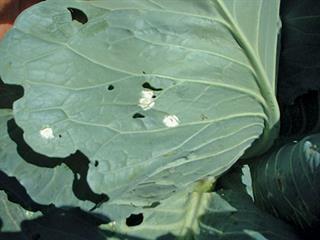
It has become more prevalent in recent years. I grew cabbages on a large scale for a long time without encountering it; now it appears fairly frequently when conditions are favourable. As with clubroot discussed in the last issue, A. candida has long been thought to be a fungus. It is now classified as an oomycete, although it is described as ‘fungus-like’ and is treated as if it were a fungus.
To date, 17 races of A. candida are known to occur around the world, with some more likely to attack cruciferous vegetables than others. Even within one crop, such as broccoli, one race will attack the leaves only, whereas another will infect the beads as well, rendering the crop unmarketable.
All cruciferous crops and a number of cruciferous weeds are susceptible to Albugo. The most notable of these is shepherd’s-purse (Capsella bursa-pastoris). Patches of this weed are often so covered in pustules that a cloud of spores is released as one walks through them. This underscores the importance of killing off weeds on the edges of a land, especially as they are a source of various other diseases and pests as well.
Widespread infestation
White blister prefers cool, moist conditions and a temperature of between 13°C and 25°C. When these are present, the disease can flare up simultaneously on a number of farms in a district. The spores require only two to three hours of free water on the plant surface at the correct temperature to germinate.
Once the spore has penetrated the plant cells, it will take six to 21 days, depending on the temperature, for the pustules or blisters to appear. These start on the underside of the leaf and will be more numerous there, although some blisters will also appear on the upper surface.
Systemic control, and avoiding resistance
Contact chemicals are ineffective on Albugo. Metalaxyl, a systemic fungicide, does control the disease. I am not sure if there are other systemic products that are equally effective; your chemical representative might be able to advise you. If there are other effective fungicides available and you vary your treatment, you will slow down the development of Albugo’s resistance to any effective product.
Many farmers neglect this important strategy. Metalaxyl itself has encountered severe resistance problems with other diseases, such as blight in potatoes.
How the spores are spread
A. candida spores can arrive with infected seed lots. This is how the disease has spread around the world. How many spores survive largely depends on the number of infected cruciferous weeds in the area. The spores are then spread throughout the land by workers, tractors, wind and rain splash. Thickened overwintering spores can form to carry the disease over to the next season.
Scientists have discovered a resistance gene. Sooner or later it may be incorporated into important cruciferous varieties. But don’t hold your breath – this takes time and white blister is not considered a major disease in most areas. Plant breeders will therefore have to decide if the expense of incorporating the gene into their parent lines is worth it.
In any case, cabbage cultivars vary in their susceptibility to Albugo. Take this into consideration when planting in a vulnerable area and at certain times of the year. If you see symptoms of Albugo, spray as soon as you can to reduce damage to the crop and to kill as many spores as possible. If you fail to do so, the disease can become a major problem if weather conditions become favourable.












